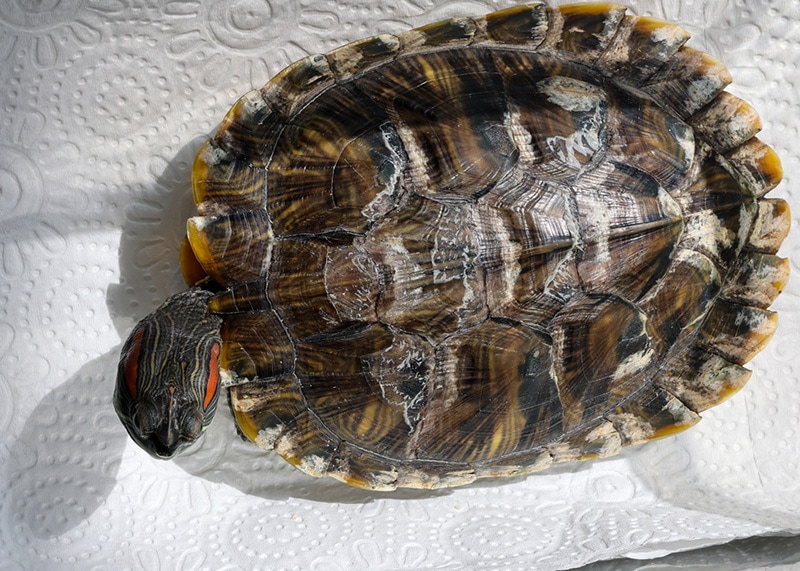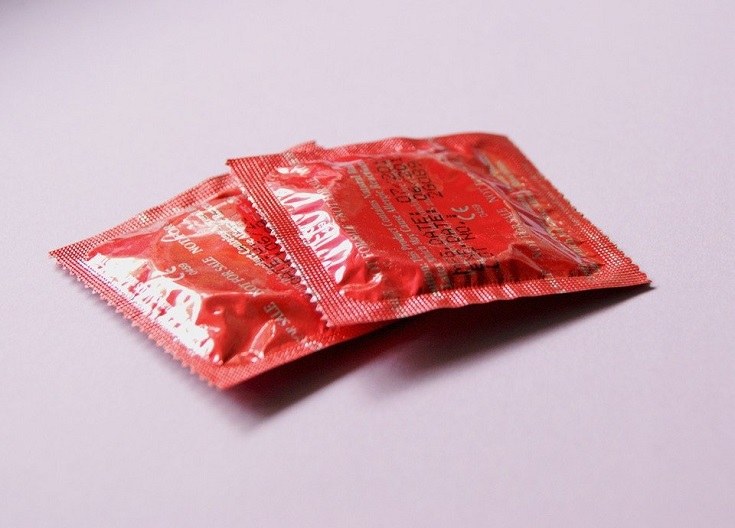Turtle Shell Rot: Signs, Causes & Treatment (Vet Answer)
Updated on

Click to Skip Ahead
Turtles and even tortoises of all species can have several health concerns in common due to how similar their anatomy is. Diseases of the shell, including shell rot, are one of these things. Shell rot can occur for several reasons and doesn’t always look exactly the same, so we’re going to help you feel confident identifying shell rot in your turtle, finding the cause, and moving forward with treatment.
What Is Turtle Shell Rot?
Shell rot is also known as ulcerative dermatitis. An infection of a turtle’s shell causes ulceration that deepens and spreads with time and can become fatal if not treated.
A turtle has a base of bone, blood vessels, and nerves covered in a keratinized layer that makes up what we know as the shell. The top of the shell is called the carapace, and the bottom is the plastron, and new layers grow from the inner layer, and turtles shed the outer layers as they grow.

What Causes Turtle Shell Rot?
In most basic terms, shell rot is caused by an infection. This infection never occurs spontaneously, though; there needs to be another underlying cause.
One common cause is a wound to the shell. Trauma-causing cracks or breaks or penetrating wounds create a pathway for bacteria to enter the shell and seed infection.
Slow, abnormal, incomplete sheds can also trap moisture beneath shedding scutes (the plates of the carapace), which allows bacteria to grow.
Improper husbandry, such as incorrect humidity levels in the enclosure (less a concern for turtles than tortoises), water quality, metabolic bone disease, or other nutritional deficiencies, can also predispose a turtle to shell rot.
For turtles that are at least partially terrestrial, if they are standing on the substrate that is too wet for too long or if that substrate isn’t clean, the shell can soften and become infected from exposure to these conditions.
Turtle shell trauma may be self-induced in trying to escape or from sharp wires or edges in the enclosure.

What Are the Signs of Turtle Shell Rot?
Unless they’re a soft-shelled turtle, all turtles should have a hard shell at all times, even in the middle of a shed. A soft spot on a turtle’s shell is usually a sign of shell rot.
Other signs may include discolorations, especially gray or white, that are usually round and will grow in size and depth with time.
In significant cases, there may be mucus or bloody discharge at these lesions on the shell or a foul odor.
In worst-case scenarios, the shell of a turtle may come off entirely, exposing the underlying structures, which almost guarantees shell rot was present.
How Is Turtle Shell Rot Diagnosed?
A physical exam that identifies shell rot lesions is enough for diagnosis. Bacterial cultures can be taken to identify what bacteria is present to cause the rot.
Some turtles may benefit from bloodwork screenings if their case isn’t mild. They may also need X-rays to rule out penetrating wounds or tracts of infection that go through the shell and into the body.
A history of trauma to the shell or a recent shed can also help with diagnosis.
How Is Turtle Shell Rot Treated?
The first step in treating shell rot is to debride the lesion. This means gently washing with soap and water, chlorhexidine, or iodine until all soft material that can exfoliate has done so. Be sure not to do this in the turtle’s enclosure or tank.
After thoroughly cleaning the lesion and removing all debris, it must be dried. If treating at home, these cleanings can be performed several times per day, which is appropriate in mild cases with small, shallow lesions.
For more severe cases, the turtle must be brought to a veterinarian. Some shell rot lesions are so deep that a turtle must undergo anesthesia before these can be debrided. Wound seals may need to be placed, or implants to hold broken shell pieces together may need to be applied.
Oral antibiotics are not uncommon in severe cases in addition to topical treatment.

How Do I Care for a Turtle With Shell Rot?
Keeping their water and enclosure clean are imperative as this is a common source of bacteria for the infection. Keeping the turtle’s environment perfect also includes monitoring temperature and humidity levels.
Sick turtles may be reluctant to eat but maintaining their nutrition is crucial for recovery, so you may need to syringe feed an appropriate diet; a veterinarian can help you with this as diet choice depends on the turtle species.
You should assess a turtle’s enclosure in case that was the cause of trauma to the shell that allowed shell rot to set in. Examples can be sharp edges or wires and areas they can fall from.
Shell rot lesions can take weeks to months to heal and should be carefully monitored through the whole healing process.
Frequently Asked Questions (FAQs)
Can turtle shell rot heal itself?
No. In most cases, turtle shell rot will continue to progress without treatment, which can ultimately lead to death, though the progression of lesions is sometimes very slow.
What ointment can I use for turtle shell rot?
Silver sulfadiazine can be applied to a shell rot lesion after it’s been cleaned and debrided. However, it should be used with caution in turtles that are fully aquatic and may be placed back into their water immediately after, as this shouldn’t be building up in their water.

Can I use hydrogen peroxide on my turtle?
This is a common suggestion online, but no. Hydrogen peroxide kills normal tissue, too, and is too harsh for proper use on wounds. Chlorhexidine, iodine, or good old-fashioned soap and water are better choices.
Can you put Neosporin on a turtle shell?
Neosporin is not generally recommended by veterinarians for use on a turtle’s shell for shell rot lesions. Oral antibiotics and repeated cleaning of the wound are a better idea. Silver sulfadiazine can be placed on a wound after cleaning when appropriate.
How do I know if shell rot is healing?
When the wound is smooth, dry (not slimy or containing discharge), has no odor, and is firm to the touch, it has healed. Scars will usually persist, but the shell has now closed the defect and cleared the infection.

 Conclusion
Conclusion
Shell rot is a serious complication for turtles but can be easily treated when caught early. Regular handling of all turtles isn’t always possible, but monitoring their shell for visible signs of a defect or trauma is important. If your turtle starts acting ill, such as eating less or becoming lethargic, it is always a good idea to check their shell for signs of rot. If you’re ever uncomfortable with the diagnosis or treatment of shell rot, a veterinarian can help you with this process.
Featured Image Credit: Dr David Sing, Shutterstock














